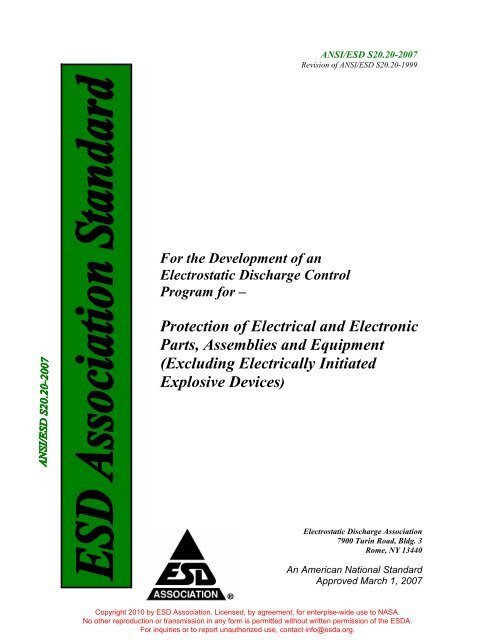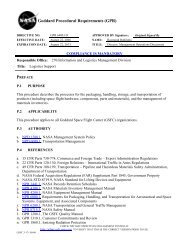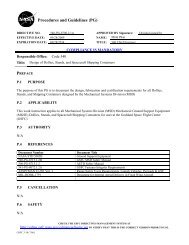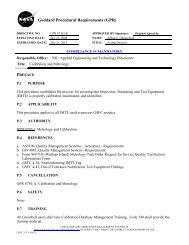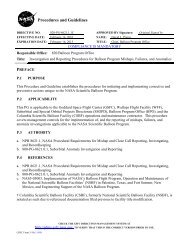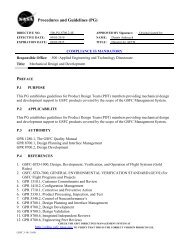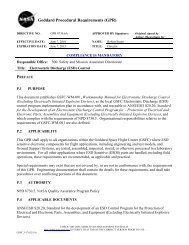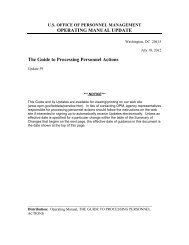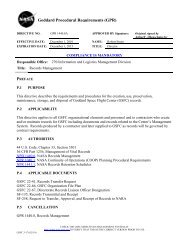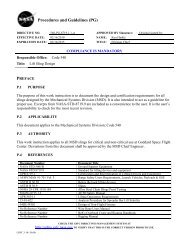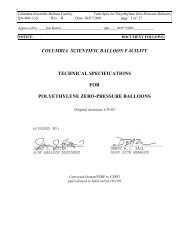ANSI ESD S20.20-2007 - FOIA and eLibrary website! - NASA
ANSI ESD S20.20-2007 - FOIA and eLibrary website! - NASA
ANSI ESD S20.20-2007 - FOIA and eLibrary website! - NASA
Create successful ePaper yourself
Turn your PDF publications into a flip-book with our unique Google optimized e-Paper software.
<strong>ANSI</strong>/<strong>ESD</strong> <strong>S20.20</strong>-<strong>2007</strong>Revision of <strong>ANSI</strong>/<strong>ESD</strong> <strong>S20.20</strong>-1999For the Development of anElectrostatic Discharge ControlProgram for –Protection of Electrical <strong>and</strong> ElectronicParts, Assemblies <strong>and</strong> Equipment(Excluding Electrically InitiatedExplosive Devices)Electrostatic Discharge Association7900 Turin Road, Bldg. 3Rome, NY 13440An American National St<strong>and</strong>ardApproved March 1, <strong>2007</strong>Copyright 2010 by <strong>ESD</strong> Association. Licensed, by agreement, for enterpise-wide use to <strong>NASA</strong>.No other reproduction or transmission in any form is permitted without written permission of the <strong>ESD</strong>A.For inquiries or to report unauthorized use, contact info@esda.org.
<strong>ESD</strong> Association St<strong>and</strong>ards CommitteeSt<strong>and</strong>ards Interpretation BulletinJune 19, 2008The <strong>ESD</strong> Association St<strong>and</strong>ards Committee is issuing this interpretation bulletin regarding<strong>ANSI</strong>/<strong>ESD</strong> <strong>S20.20</strong>-<strong>2007</strong>. This bulletin modifies the requirements specified in Table 3 EPAControl Items (Garments). Table 3 should now be modified to disregard the two garment types;“Groundable Static Control Garment” <strong>and</strong> “Groundable Static Control Garment System”, alongwith their Test Methods <strong>and</strong> Requirements.Additionally, the “Static Control Garment” Required Limit should be: 1 x 10 5 ohms to 1 x 10 11ohms, per <strong>ANSI</strong>/<strong>ESD</strong> STM2.1-1997.These changes are necessary because the referenced document, <strong>ANSI</strong>/<strong>ESD</strong> STM2.1, has beenbrought back to a Work in Progress (WIP) status <strong>and</strong> therefore these two garment types(mentioned above) are also brought back to WIP status.Reference InformationTable 3. EPA <strong>ESD</strong> Control ItemsTechnicalRequirement<strong>ESD</strong> ControlItemGarmentsProduct Qualification 1Test MethodStatic Control Garment(<strong>ANSI</strong>/<strong>ESD</strong> STM2.1)Groundable StaticControl Garment(<strong>ANSI</strong>/<strong>ESD</strong> STM2.1)Groundable StaticControl GarmentSystem(<strong>ANSI</strong>/<strong>ESD</strong> STM2.1)Compliance VerificationRequiredLimit(s) 2 Test Method Required Limit(s)< 1 x 10 11 <strong>ESD</strong> TR53ohms< 1 x 10 11 ohmsGarments Section< 1 x 10 9 ohms< 3.5 x 10 7 ohms<strong>ESD</strong> TR53Garments Section<strong>ESD</strong> TR53Garments Section< 1 x 10 9 ohms< 3.5 x 10 7 ohmsJohn KinnearWorking Group ChairmanTim JarrettSt<strong>and</strong>ards ChairmanCopyright 2010 by <strong>ESD</strong> Association. Licensed, by agreement, for enterpise-wide use to <strong>NASA</strong>.No other reproduction or transmission in any form is permitted without written permission of the <strong>ESD</strong>A.For inquiries or to report unauthorized use, contact info@esda.org.
<strong>ESD</strong> Association St<strong>and</strong>ards CommitteeSt<strong>and</strong>ards Change NotificationJune 14, <strong>2007</strong>This notification reports on two typos in <strong>ANSI</strong>/<strong>ESD</strong> <strong>S20.20</strong>-<strong>2007</strong>, Table 2 Personnel GroundingRequirement. These corrections have been made to the St<strong>and</strong>ard <strong>and</strong> are highlighted below foryour reference.Previous InformationTable 2. Personnel Grounding RequirementPersonnelGroundingTechnicalRequirementWrist Strap System 2 <strong>ANSI</strong>/<strong>ESD</strong> S1.1(Section 5.10)Product Qualification 1Compliance VerificationTest Method Required Limit(s) Test Method Required Limit(s)0.8 x 10 6 to1.2 x 10 6 ohms<strong>ESD</strong> TR53Wrist Strap Section< 3.5 x 10 7 ohmsCurrent InformationTable 2. Personnel Grounding RequirementPersonnelGroundingTechnicalRequirementWrist Strap System 2 <strong>ANSI</strong>/<strong>ESD</strong> S1.1(Section 5.11)Product Qualification 1Compliance VerificationTest Method Required Limit(s) Test Method Required Limit(s)< 3.5 x 10 7 ohms<strong>ESD</strong> TR53Wrist Strap Section< 3.5 x 10 7 ohmsJohn KinnearWorking Group ChairmanTim JarrettSt<strong>and</strong>ards ChairmanComments can be sent to the <strong>ESD</strong> Association by one of the following methods:Email: info@esda.orgFax: 315-339-6793Copyright 2010 by <strong>ESD</strong> Association. Licensed, by agreement, for enterpise-wide use to <strong>NASA</strong>.No other reproduction or transmission in any form is permitted without written permission of the <strong>ESD</strong>A.For inquiries or to report unauthorized use, contact info@esda.org.
<strong>ANSI</strong>/<strong>ESD</strong> <strong>S20.20</strong>-<strong>2007</strong><strong>ESD</strong> Association St<strong>and</strong>ardfor the Development of an Electrostatic DischargeControl Program for –Protection of Electrical <strong>and</strong> Electronic Parts, Assemblies<strong>and</strong> Equipment (Excluding Electrically InitiatedExplosive Devices)Approved February 11, <strong>2007</strong><strong>ESD</strong> Association®Copyright 2010 by <strong>ESD</strong> Association. Licensed, by agreement, for enterpise-wide use to <strong>NASA</strong>.No other reproduction or transmission in any form is permitted without written permission of the <strong>ESD</strong>A.For inquiries or to report unauthorized use, contact info@esda.org.
<strong>ANSI</strong>/<strong>ESD</strong> <strong>S20.20</strong>-<strong>2007</strong>CAUTIONNOTICEElectrostatic Discharge Association (<strong>ESD</strong>A) st<strong>and</strong>ards <strong>and</strong> publications are designed toserve the public interest by eliminating misunderst<strong>and</strong>ings between manufacturers <strong>and</strong>purchasers, facilitating the interchangeability <strong>and</strong> improvement of products <strong>and</strong> assistingthe purchaser in selecting <strong>and</strong> obtaining the proper product for his particular needs. Theexistence of such st<strong>and</strong>ards <strong>and</strong> publications shall not in any respect preclude any memberor non-member of the Association from manufacturing or selling products not conforming tosuch st<strong>and</strong>ards <strong>and</strong> publications. Nor shall the fact that a st<strong>and</strong>ard or publication ispublished by the Association preclude its voluntary use by non-members of the Associationwhether the document is to be used either domestically or internationally. Recommendedst<strong>and</strong>ards <strong>and</strong> publications are adopted by the <strong>ESD</strong>A in accordance with the <strong>ANSI</strong> Patentpolicy.Interpretation of <strong>ESD</strong>A St<strong>and</strong>ards: The interpretation of st<strong>and</strong>ards in-so-far as it may relateto a specific product or manufacturer is a proper matter for the individual companyconcerned <strong>and</strong> cannot be undertaken by any person acting for the <strong>ESD</strong>A. The <strong>ESD</strong>ASt<strong>and</strong>ards Chairman may make comments limited to an explanation or clarification of thetechnical language or provisions in a st<strong>and</strong>ard, but not related to its application to specificproducts <strong>and</strong> manufacturers. No other person is authorized to comment on behalf of the<strong>ESD</strong>A on any <strong>ESD</strong>A St<strong>and</strong>ard.DISCLAIMER OFWARRANTIESTHE CONTENTS OF <strong>ESD</strong>A’S STANDARDS AND PUBLICATIONS ARE PROVIDED “AS-IS,” AND <strong>ESD</strong>A MAKES NO REPRESENTATIONS OR WARRANTIES, EXPRESS ORIMPLIED, OF ANY KIND WITH RESPECT TO SUCH CONTENTS. <strong>ESD</strong>A DISCLAIMSALL REPRESENTATIONS AND WARRANTIES, INCLUDING WITHOUT LIMITATION,WARRANTIES OF MERCHANTABILITY, FITNESS FOR PARTICULAR PURPOSE ORUSE, TITLE AND NON-INFRINGEMENT.DISCLAIMER OF GUARANTY: <strong>ESD</strong>A STANDARDS AND PUBLICATIONS ARECONSIDERED TECHNICALLY SOUND AT THE TIME THEY ARE APPROVED FORPUBLICATION. THEY ARE NOT A SUBSTITUTE FOR A PRODUCT SELLER’S ORUSER’S OWN JUDGMENT WITH RESPECT TO ANY PARTICULAR PRODUCTDISCUSSED, AND <strong>ESD</strong>A DOES NOT UNDERTAKE TO GUARANTY THEPERFORMANCE OF ANY INDIVIDUAL MANUFACTURERS’ PRODUCTS BY VIRTUEOF SUCH STANDARDS OR PUBLICATIONS. THUS, <strong>ESD</strong>A EXPRESSLY DISCLIAMSANY RESPONSIBILITY FOR DAMAGES ARISING FROM THE USE, APPLICATION, ORRELIANCE BY OTHERS ON THE INFORMATION CONTAINED IN THESE STANDARDSOR PUBLICATIONS.LIMITATION ON <strong>ESD</strong>A’S LIABILITY: NEITHER <strong>ESD</strong>A, NOR ITS MEMBERS,OFFICERS, EMPLOYEES OR OTHER REPRESENTATIVES WILL BE LIABLE FORDAMAGES ARISING OUT OF OR IN CONNECTION WITH THE USE OR MISUSE OF<strong>ESD</strong>A STANDARDS OR PUBLICATIONS, EVEN IF ADVISED OF THE POSSIBILITYTHEREOF. THIS IS A COMPREHENSIVE LIMITATION OF LIABILITY THAT APPLIESTO ALL DAMAGES OF ANY KIND, INCLUDING WITHOUT LIMITATION, LOSS OFDATA, INCOME OR PROFIT, LOSS OF OR DAMAGE TO PROPERTY AND CLAIMS OFTHIRD PARTIES.Published by:Electrostatic Discharge Association7900 Turin Road, Bldg. 3Rome, NY 13440Copyright © <strong>2007</strong> by <strong>ESD</strong> AssociationAll rights reservedNo part of this publication may be reproduced in any form, inan electronic retrieval system or otherwise, without the priorwritten permission of the publisher.Printed in the United States of AmericaISBN: 1-58537-121-1Copyright 2010 by <strong>ESD</strong> Association. Licensed, by agreement, for enterpise-wide use to <strong>NASA</strong>.No other reproduction or transmission in any form is permitted without written permission of the <strong>ESD</strong>A.For inquiries or to report unauthorized use, contact info@esda.org.
<strong>ANSI</strong>/<strong>ESD</strong> <strong>S20.20</strong>-<strong>2007</strong>(This foreword is not part of <strong>ANSI</strong>/<strong>ESD</strong> <strong>S20.20</strong>-<strong>2007</strong>)FOREWORDThis st<strong>and</strong>ard covers the requirements necessary to design, establish, implement <strong>and</strong> maintainan Electrostatic Discharge (<strong>ESD</strong>) Control Program for activities that manufacture, process,assemble, install, package, label, service, test, inspect or otherwise h<strong>and</strong>le electrical or electronicparts, assemblies <strong>and</strong> equipment susceptible to damage by electrostatic discharges greater thanor equal to 100 volts Human Body Model (HBM). This document covers the <strong>ESD</strong> ControlProgram requirements <strong>and</strong> offers guidance for setting up a program to h<strong>and</strong>le <strong>ESD</strong> sensitive(<strong>ESD</strong>S) items, based on the historical experience of both military <strong>and</strong> commercial organizations.References include <strong>ESD</strong> Association, U.S. Military <strong>and</strong> <strong>ANSI</strong> approved st<strong>and</strong>ards for materialproperties <strong>and</strong> test methods. The fundamental <strong>ESD</strong> control principles that form the basis of thisdocument are:A. All conductors in the environment, including personnel, shall be bonded orelectrically connected <strong>and</strong> attached to a known ground or contrived ground (as onshipboard or on aircraft). This attachment creates an equipotential balancebetween all items <strong>and</strong> personnel. Electrostatic protection can be maintained at apotential above a “zero” voltage ground potential as long as all items in the systemare at the same potential.B. Necessary non-conductors in the environment cannot lose their electrostaticcharge by attachment to ground. Ionization systems provide neutralization ofcharges on these necessary non-conductive items (circuit board materials <strong>and</strong>some device packages are examples of necessary non-conductors). Assessmentof the <strong>ESD</strong> hazard created by electrostatic charges on the necessary nonconductorsin the work place is required to ensure that appropriate actions areimplemented, commensurate with risk to <strong>ESD</strong>S items.C. Transportation of <strong>ESD</strong>S items outside an <strong>ESD</strong> Protected Area (hereafterreferred to as “EPA”) requires enclosure in static protective materials, although thetype of material depends on the situation <strong>and</strong> destination. Inside an EPA, lowcharging <strong>and</strong> static dissipative materials may provide adequate protection. Outsidean EPA, low charging <strong>and</strong> static discharge shielding materials are recommended.While these materials are not discussed in the document, it is important torecognize the differences in their application. For more clarification see <strong>ANSI</strong>/<strong>ESD</strong>S541.Any relative motion <strong>and</strong> physical separation of materials or flow of solids, liquids or particle-ladengases can generate electrostatic charges. Common sources of <strong>ESD</strong> include personnel, itemsmade from common polymeric materials, <strong>and</strong> processing equipment. <strong>ESD</strong> damage can occurwhen:i. A charged object comes into contact with an <strong>ESD</strong>S device, orii. An <strong>ESD</strong>S device is grounded while exposed to an electrostatic field.Examples of <strong>ESD</strong>S parts are microcircuits, discrete semiconductors, thick <strong>and</strong> thin film resistors,hybrid devices, printed circuit boards <strong>and</strong> piezoelectric crystals. It is possible to determinedevice <strong>and</strong> item susceptibility by exposing the device to simulated <strong>ESD</strong> events. The level ofsensitivity, determined by testing using simulated <strong>ESD</strong> events, may not necessarily relate to thelevel of sensitivity in a real life situation. However, they are used to establish a baseline ofsusceptibility data for comparison of devices with equivalent part numbers from differentmanufacturers. Three different models are used for characterization of electronic components:HBM, Machine Model (MM), <strong>and</strong> Charged Device Model (CDM).Copyright 2010 by <strong>ESD</strong> Association. Licensed, by agreement, for enterpise-wide use to <strong>NASA</strong>.No other reproduction or transmission in any form is permitted without written permission of the <strong>ESD</strong>A.For inquiries or to report unauthorized use, contact info@esda.org.i
<strong>ANSI</strong>/<strong>ESD</strong> <strong>S20.20</strong>-<strong>2007</strong>This document was originally designated <strong>ANSI</strong>/<strong>ESD</strong> <strong>S20.20</strong>-1999 <strong>and</strong> approved on August 4, 1999.<strong>ANSI</strong>/<strong>ESD</strong> <strong>S20.20</strong>-1999 was prepared by the 20.20 Mil-Std 1686 Conversion Committee. <strong>ANSI</strong>/<strong>ESD</strong><strong>S20.20</strong>-<strong>2007</strong> is a revision of <strong>ANSI</strong>/<strong>ESD</strong> <strong>S20.20</strong>-1999 <strong>and</strong> was prepared by the <strong>S20.20</strong> Writing Team,which consists of the following members:Ron GibsonCelesticaSteve GerkenUSAFJohn T. Kinnear Jr.IBMThe following individuals made significant contributions to this document:Jeremy SmallwoodElectrostatic Solutions Ltd.Reinhold GaertnerInfineon TechnologiesAt the time the <strong>S20.20</strong>-1999 version was prepared, the 20.20 Mil-Std 1686 Conversion Committeehad the following members:Steve Gerken, Co-ChairmanUSAFAnthony KlinowskiBoeingDave Leeson, Co-ChairmanMotorola SSTGGarry McGuire<strong>NASA</strong>(Hern<strong>and</strong>ez Engineering)Thomas MohlerRaytheon Systems CorporationDavid E. Swenson3MRon GibsonCelesticaThe following individuals made significant contributions to this document:Ronald L. JohnsonIntelDonald E. CrossUSNJeffrey ScanlonASCRobert ParrConsultantSheryl ZayicBoeingJohn T. Kinnear Jr.IBMJoel WeidendorfConsultantRobert Cummings<strong>NASA</strong>Ralph MyersASCiiCopyright 2010 by <strong>ESD</strong> Association. Licensed, by agreement, for enterpise-wide use to <strong>NASA</strong>.No other reproduction or transmission in any form is permitted without written permission of the <strong>ESD</strong>A.For inquiries or to report unauthorized use, contact info@esda.org.
<strong>ANSI</strong>/<strong>ESD</strong> <strong>S20.20</strong>-<strong>2007</strong>TABLE OF CONTENTS1.0 PURPOSE ............................................................................................................................... 12.0 SCOPE .................................................................................................................................... 13.0 REFERENCED PUBLICATIONS............................................................................................ 14.0 DEFINITIONS.......................................................................................................................... 25.0 PERSONNEL SAFETY........................................................................................................... 26.0 <strong>ESD</strong> CONTROL PROGRAM .................................................................................................. 26.1 <strong>ESD</strong> CONTROL PROGRAM REQUIREMENTS ............................................................................ 26.2 <strong>ESD</strong> CONTROL PROGRAM MANAGER OR COORDINATOR......................................................... 26.3 TAILORING............................................................................................................................ 27.0 <strong>ESD</strong> CONTROL PROGRAM ADMINISTRATIVE REQUIREMENTS .................................... 27.1 <strong>ESD</strong> CONTROL PROGRAM PLAN............................................................................................ 27.2 TRAINING PLAN..................................................................................................................... 37.3 COMPLIANCE VERIFICATION PLAN.......................................................................................... 38.0 <strong>ESD</strong> CONTROL PROGRAM PLAN TECHNICAL REQUIREMENTS ................................... 38.1 GROUNDING / EQUIPOTENTIAL BONDING SYSTEMS ................................................................. 38.2 PERSONNEL GROUNDING ...................................................................................................... 48.3 <strong>ESD</strong> PROTECTED AREAS (EPAS).......................................................................................... 58.4 PACKAGING .......................................................................................................................... 78.5 MARKING.............................................................................................................................. 7ANNEX A – ADDITIONAL PROCESS CONSIDERATIONS ......................................................... 8ANNEX B – <strong>ESD</strong> SENSITIVITY TESTING ..................................................................................... 9ANNEX C – RELATED DOCUMENTS......................................................................................... 12TABLESTable 1. Grounding / Equipotential Bonding Requirements........................................................... 4Table 2. Personnel Grounding Requirement.................................................................................. 4Table 3. EPA <strong>ESD</strong> Control Items.................................................................................................... 6Table 4. <strong>ESD</strong> Susceptibility Test References for Devices ........................................................... 10Table 5. <strong>ESD</strong> Susceptibility Test References for Assemblies <strong>and</strong> Equipment ............................ 11Copyright 2010 by <strong>ESD</strong> Association. Licensed, by agreement, for enterpise-wide use to <strong>NASA</strong>.No other reproduction or transmission in any form is permitted without written permission of the <strong>ESD</strong>A.For inquiries or to report unauthorized use, contact info@esda.org.iii
<strong>ESD</strong> Association St<strong>and</strong>ard<strong>ANSI</strong>/<strong>ESD</strong> <strong>S20.20</strong>-<strong>2007</strong><strong>ESD</strong> Association St<strong>and</strong>ard for the Development of an Electrostatic Discharge ControlProgram for Protection of Electrical <strong>and</strong> Electronic Parts, Assemblies <strong>and</strong> Equipment(Excluding Electrically Initiated Explosive Devices)1.0 PURPOSEThe purpose of this st<strong>and</strong>ard is to provide administrative <strong>and</strong> technical requirements forestablishing, implementing <strong>and</strong> maintaining an <strong>ESD</strong> Control Program (hereafter referred to as the“Program”).2.0 SCOPEThis document applies to activities that manufacture, process, assemble, install, package, label,service, test, inspect, transport or otherwise h<strong>and</strong>le electrical or electronic parts, assemblies <strong>and</strong>equipment susceptible to damage by electrostatic discharges greater than or equal to 100 voltsHBM. Activities that h<strong>and</strong>le items that are susceptible to less than 100 volts HBM may requireadditional control elements or adjusted limits. Processes designed to h<strong>and</strong>le items that have an<strong>ESD</strong> sensitivity less than 100 volts HBM can still claim compliance to this st<strong>and</strong>ard. Thisdocument does not apply to electrically initiated explosive devices, flammable liquids or powders.3.0 REFERENCED PUBLICATIONSUnless otherwise specified, the following documents of the latest issue, revision or amendmentform a part of this st<strong>and</strong>ard to the extent specified herein:<strong>ESD</strong> ADV1.0, <strong>ESD</strong> Association’s Glossary of Terms 1<strong>ANSI</strong>/<strong>ESD</strong> S1.1, Wrist Straps 1<strong>ANSI</strong>/<strong>ESD</strong> STM2.1, Garments 1<strong>ANSI</strong>/<strong>ESD</strong> STM3.1, Ionization 1<strong>ANSI</strong>/<strong>ESD</strong> SP3.3, Periodic Verification of Air Ionizers 1<strong>ANSI</strong>/<strong>ESD</strong> S4.1, Worksurfaces – Resistance Measurements 1<strong>ANSI</strong>/<strong>ESD</strong> STM4.2, <strong>ESD</strong> Protective Worksurfaces – Charge Dissipation Characteristics 1<strong>ANSI</strong>/<strong>ESD</strong> S6.1, Grounding 1<strong>ANSI</strong>/<strong>ESD</strong> S7.1, Floor Materials – Characterization of Materials 1<strong>ANSI</strong>/<strong>ESD</strong> STM9.1, Footwear – Resistive Characterization 1<strong>ESD</strong> SP9.2, Footwear – Foot Grounders Resistive Characterization 1<strong>ANSI</strong>/<strong>ESD</strong> STM97.1, Floor Materials <strong>and</strong> Footwear – Resistance Measurement in Combinationwith a Person 1<strong>ANSI</strong>/<strong>ESD</strong> STM97.2, Floor Materials <strong>and</strong> Footwear – Voltage Measurement in Combination witha Person 1<strong>ESD</strong> TR53, Compliance Verification of <strong>ESD</strong> Protective Equipment <strong>and</strong> Materials 1<strong>ANSI</strong>/<strong>ESD</strong> STM12.1, Seating – Resistive Measurement 1<strong>ANSI</strong>/<strong>ESD</strong> S541, Packaging Materials for <strong>ESD</strong> Sensitive Items 11 <strong>ESD</strong> Association, 7900 Turin Road, Bldg. 3, Ste. 2, Rome, NY 13440-2069, 315-339-69371Copyright 2010 by <strong>ESD</strong> Association. Licensed, by agreement, for enterpise-wide use to <strong>NASA</strong>.No other reproduction or transmission in any form is permitted without written permission of the <strong>ESD</strong>A.For inquiries or to report unauthorized use, contact info@esda.org.
<strong>ANSI</strong>/<strong>ESD</strong> <strong>S20.20</strong>-<strong>2007</strong>4.0 DEFINITIONSThe terms used in the body of this document are in accordance with the definitions found in <strong>ESD</strong>ADV1.0, <strong>ESD</strong> Association’s Glossary of Terms.5.0 PERSONNEL SAFETYThe procedures <strong>and</strong> equipment described in this document may expose personnel to hazardouselectrical conditions. Users of this document are responsible for selecting equipment thatcomplies with applicable laws, regulatory codes <strong>and</strong> both external <strong>and</strong> internal policy. Users arecautioned that this document cannot replace or supersede any requirements for personnel safety.Ground fault circuit interrupters (GFCI) <strong>and</strong> other safety protection should be consideredwherever personnel might come into contact with electrical sources.Electrical hazard reduction practices should be exercised <strong>and</strong> proper grounding instructions forequipment shall be followed.6.0 <strong>ESD</strong> CONTROL PROGRAM6.1 <strong>ESD</strong> Control Program RequirementsThe Program shall include both administrative <strong>and</strong> technical requirements as described herein.The most sensitive level of the items to be h<strong>and</strong>led, in accordance with the Program, shall bedocumented. The Organization shall establish, document, implement, maintain <strong>and</strong> verify thecompliance of the Program in accordance with the requirements of this document.6.2 <strong>ESD</strong> Control Program Manager or CoordinatorAn <strong>ESD</strong> Control Program Manager or Coordinator shall be assigned by the Organization to verifythe compliance of the Program in accordance with the requirements of this document.6.3 TailoringThis document, or portions thereof, may not apply to all applications. Tailoring is accomplishedby evaluating the applicability of each requirement for the specific application. Upon completionof the evaluation, requirements may be added, modified or deleted. Tailoring decisions, includingrationale <strong>and</strong> technical justifications, shall be documented in the <strong>ESD</strong> Control Program Plan.7.0 <strong>ESD</strong> CONTROL PROGRAM ADMINISTRATIVE REQUIREMENTS7.1 <strong>ESD</strong> Control Program PlanThe Organization shall prepare an <strong>ESD</strong> Control Program Plan that addresses each of therequirements of the Program. Those requirements include:• Training• Compliance Verification• Grounding / Equipotential Bonding Systems• Personnel Grounding• EPA Requirements• Packaging Systems• MarkingCopyright 2010 by <strong>ESD</strong> Association. Licensed, by agreement, for enterpise-wide use to <strong>NASA</strong>.No other reproduction or transmission in any form is permitted without written permission of the <strong>ESD</strong>A.For inquiries or to report unauthorized use, contact info@esda.org.2
<strong>ANSI</strong>/<strong>ESD</strong> <strong>S20.20</strong>-<strong>2007</strong>The <strong>ESD</strong> Control Program Plan is the principal document for implementing <strong>and</strong> verifying theProgram. The goal is a fully implemented <strong>and</strong> integrated Program that conforms to internalquality system requirements. The <strong>ESD</strong> Control Program Plan shall apply to all applicable facetsof the Organization’s work.7.2 Training PlanInitial <strong>and</strong> recurrent <strong>ESD</strong> awareness <strong>and</strong> prevention training shall be provided to all personnelwho h<strong>and</strong>le or otherwise come into contact with any <strong>ESD</strong>S items. Initial training shall be providedbefore personnel h<strong>and</strong>le <strong>ESD</strong>S items. The type <strong>and</strong> frequency of <strong>ESD</strong> training for personnel shallbe defined in the Training Plan. The Training Plan shall include a requirement for maintainingemployee training records <strong>and</strong> shall document where the records are stored. Training methods<strong>and</strong> the use of specific techniques are at the Organization’s discretion. The training plan shallinclude the methods used by the Organization to verify trainee comprehension <strong>and</strong> trainingadequacy.7.3 Compliance Verification PlanA Compliance Verification Plan shall be established to ensure the Organization’s fulfillment of thetechnical requirements of the <strong>ESD</strong> Control Program Plan. Process monitoring (measurements)shall be conducted in accordance with a Compliance Verification Plan that identifies the technicalrequirements to be verified, the measurement limits <strong>and</strong> the frequency at which thoseverifications shall occur. The Compliance Verification Plan shall document the test methods <strong>and</strong>equipment used for process monitoring <strong>and</strong> measurements. If the test methods used by theOrganization differ from any of the st<strong>and</strong>ards referenced in this document, then there must be atailoring statement that is documented as part of the <strong>ESD</strong> Control Program Plan. Complianceverification records shall be established <strong>and</strong> maintained to provide evidence of conformity to thetechnical requirements.The test equipment selected shall be capable of making the measurements defined in theCompliance Verification Plan.8.0 <strong>ESD</strong> CONTROL PROGRAM PLAN TECHNICAL REQUIREMENTSThe following sections, Sections 8.1 to 8.5, describe the key technical requirements used in thedevelopment of an <strong>ESD</strong> Control Program.The required limits are based on the test methods or st<strong>and</strong>ards listed in each table. TheCompliance Verification Plan shall document the methods used to verify the limits.8.1 Grounding / Equipotential Bonding SystemsGrounding / Equipotential Bonding Systems shall be used to ensure that <strong>ESD</strong>S items, personnel<strong>and</strong> any other conductors (e.g., mobile equipment) are at the same electrical potential. Animplementing process shall be selected from Table 1.3Copyright 2010 by <strong>ESD</strong> Association. Licensed, by agreement, for enterpise-wide use to <strong>NASA</strong>.No other reproduction or transmission in any form is permitted without written permission of the <strong>ESD</strong>A.For inquiries or to report unauthorized use, contact info@esda.org.
<strong>ANSI</strong>/<strong>ESD</strong> <strong>S20.20</strong>-<strong>2007</strong>Table 1. Grounding / Equipotential Bonding RequirementsTechnical Requirement Implementing Process Test Method Required Limit(s)Grounding / BondingSystemEquipment GroundingConductor<strong>ANSI</strong>/<strong>ESD</strong> S6.1 < 1.0 ohm impedanceAuxiliary Ground <strong>ANSI</strong>/<strong>ESD</strong> S6.1< 25 ohms to theEquipment GroundingConductorEquipotential Bonding <strong>ANSI</strong>/<strong>ESD</strong> S6.1 < 1.0 x 10 9 ohms 11 The maximum resistance between any <strong>ESD</strong> technical element <strong>and</strong> the common connection point.8.2 Personnel GroundingAll personnel shall be bonded or electrically connected to the grounding / equipotential bondingsystem when h<strong>and</strong>ling <strong>ESD</strong>S items. The personnel grounding method(s) shall be selected fromTable 2.NOTE: Use of a garment to achieve personnel grounding shall be documented in the <strong>ESD</strong> ControlProgram Plan. The garment shall be electrically conductive from one sleeve to the next <strong>and</strong> mustalso meet the system resistance requirements defined in Note 2 in Table 2.When personnel are seated at <strong>ESD</strong> protective workstations, they shall be connected to thegrounding / equipotential bonding system via a wrist strap system.For st<strong>and</strong>ing operations, personnel shall be grounded via a wrist strap system or by a flooringfootwearsystem. When a flooring-footwear system is used, one of the two following conditionsshall be met:A. When the total resistance of the system (from the person, through the footwear <strong>and</strong>flooring to the grounding / equipotential bonding system) is less than 3.5 x 10 7 ohms,Method 1 shall be followed (see Table 2).B. When the total resistance of the system (from the person, through the footwear <strong>and</strong>flooring to the grounding / equipotential bonding system) is greater than 3.5 x 10 7ohms <strong>and</strong> less than 1 x 10 9 ohms, Method 2 shall be followed (see Table 2).Table 2. Personnel Grounding RequirementPersonnelProduct Qualification 1Compliance VerificationGroundingTechnicalTest Method Required Limit(s) Test Method Required Limit(s)RequirementWrist Strap <strong>ANSI</strong>/<strong>ESD</strong> S1.1System 2 (Section 5.11)Flooring / FootwearSystem – Method 1Flooring / FootwearSystem – Method 2(both required)<strong>ANSI</strong>/<strong>ESD</strong>STM97.1<strong>ANSI</strong>/<strong>ESD</strong>STM97.1<strong>ANSI</strong>/<strong>ESD</strong>STM97.2< 3.5 x 10 7 ohms< 3.5 x 10 7 ohms< 10 9 ohms< 100 volts<strong>ESD</strong> TR53Wrist Strap Section<strong>ESD</strong> TR53Flooring Section<strong>ESD</strong> TR53Footwear Section<strong>ESD</strong> TR53Flooring Section<strong>ESD</strong> TR53Footwear Section< 3.5 x 10 7 ohms< 3.5 x 10 7 ohms< 3.5 x 10 7 ohms< 1.0 x 10 9 ohms< 1.0 x 10 9 ohms1Product qualification is normally conducted during the initial selection of <strong>ESD</strong> control products <strong>and</strong> materials. Any of thefollowing methods can be used: product specification review, independent laboratory evaluation or internal laboratoryevaluation.2 For situations where an <strong>ESD</strong> garment is used as part of the wrist strap grounding path, the total system resistanceincluding the person, garment <strong>and</strong> grounding cord shall be less than 3.5 x 10 7 ohms.Copyright 2010 by <strong>ESD</strong> Association. Licensed, by agreement, for enterpise-wide use to <strong>NASA</strong>.No other reproduction or transmission in any form is permitted without written permission of the <strong>ESD</strong>A.For inquiries or to report unauthorized use, contact info@esda.org.4
<strong>ANSI</strong>/<strong>ESD</strong> <strong>S20.20</strong>-<strong>2007</strong>8.3 <strong>ESD</strong> Protected Areas (EPAs)H<strong>and</strong>ling of <strong>ESD</strong>S parts, assemblies <strong>and</strong> equipment without <strong>ESD</strong> protective covering orpackaging shall be performed in an EPA. Caution signs indicating the existence of the EPA shallbe posted <strong>and</strong> clearly visible to personnel prior to entry to the EPA.NOTE: An EPA can consist of a single workstation, entire room or building.Access to the EPA shall be limited to personnel who have completed appropriate <strong>ESD</strong> training.Untrained individuals shall be escorted by trained personnel while in an EPA.In order to mitigate field-induced CDM damage, the <strong>ESD</strong> program shall include a plan for theh<strong>and</strong>ling of process-required insulators. If the field exceeds 2,000 volts/inch, steps shall be takento either:A) Separate the insulator from the <strong>ESD</strong>-sensitive device by a distance of 30 cm (12 inches);orB) Use ionization or other charge mitigating techniques to neutralize the charge.NOTE: The accurate measurement of electrostatic fields requires that the person making themeasurement is familiar with the operation of the measuring equipment. Most h<strong>and</strong> held metersrequire that the reading be taken at a fixed distance from the object. They also normally specify thatthe object has a minimum dimension of fixed size in order to get an accurate reading.All nonessential insulators such as coffee cups, food wrappers <strong>and</strong> personal items shall beremoved from the workstation or any operation where unprotected <strong>ESD</strong>S items are h<strong>and</strong>led.An EPA shall be established wherever <strong>ESD</strong>S products are h<strong>and</strong>led. However, there are manydifferent ways to establish <strong>ESD</strong> controls within an EPA. Table 3 lists some optional <strong>ESD</strong> controlitems which can be used to control static electricity. For those <strong>ESD</strong> control items that areselected for use in the <strong>ESD</strong> Control Program, the required limits <strong>and</strong> test methods for that itembecomes m<strong>and</strong>atory.5Copyright 2010 by <strong>ESD</strong> Association. Licensed, by agreement, for enterpise-wide use to <strong>NASA</strong>.No other reproduction or transmission in any form is permitted without written permission of the <strong>ESD</strong>A.For inquiries or to report unauthorized use, contact info@esda.org.
<strong>ANSI</strong>/<strong>ESD</strong> <strong>S20.20</strong>-<strong>2007</strong>Table 3. EPA <strong>ESD</strong> Control ItemsTechnicalRequirementEPA<strong>ESD</strong> ControlItemWorksurfaceWrist StrapCordWrist StrapCuffProduct Qualification 1Test Method<strong>ANSI</strong>/<strong>ESD</strong> S 4.1<strong>and</strong>/or<strong>ANSI</strong>/<strong>ESD</strong> STM 4.2<strong>ANSI</strong>/<strong>ESD</strong> S1.1<strong>ANSI</strong>/<strong>ESD</strong> S1.1RequiredLimit(s) 2< 1 x 10 9 ohms<strong>and</strong>/or< 200 volts0.8 x 10 6 to1.2 x 10 6 ohmsInterior< 1 x 10 5 ohmsExterior> 1 x 10 7 ohmsCompliance VerificationTest Method<strong>ESD</strong> TR53WorksurfaceSectionRequiredLimit(s)< 1 x 10 9 ohmsresistance togroundFor compliance verification of a wriststrap system, see Table 2.Wrist StrapCord BendingLife<strong>ANSI</strong>/<strong>ESD</strong> S1.1 > 16,000 cyclesFootwear <strong>ANSI</strong>/<strong>ESD</strong> STM9.1 < 1 x 10 9 ohms See Table 2 See Table 2FootGrounders<strong>ESD</strong> SP9.2 < 1 x 10 9 ohms See Table 2 See Table 2Flooring <strong>ANSI</strong>/<strong>ESD</strong> S7.1 < 1 x 10 9 ohms See Table 2 See Table 2SeatingIonizationother thanRoom SystemsIonization(RoomSystems)<strong>ANSI</strong>/<strong>ESD</strong>STM 12.1<strong>ANSI</strong>/<strong>ESD</strong> STM 3.1- Discharge time- Offset voltage<strong>ANSI</strong>/<strong>ESD</strong> STM3.1- Discharge time- Offset voltage< 1 x 10 9 ohmsUser defined< ± 50 voltsUser defined< ± 150 voltsShelving <strong>ANSI</strong>/<strong>ESD</strong> S4.1 < 1 x 10 9 ohmsMobileEquipment(WorkingSurfaces)ContinuousMonitorsGarments<strong>ANSI</strong>/<strong>ESD</strong> S4.1User definedStatic ControlGarment(<strong>ANSI</strong>/<strong>ESD</strong> STM2.1)Groundable StaticControl Garment(<strong>ANSI</strong>/<strong>ESD</strong> STM2.1)Groundable StaticControl GarmentSystem(<strong>ANSI</strong>/<strong>ESD</strong> STM2.1)< 1 x 10 9 ohmsUser defined< 1 x 10 11 ohms< 1 x 10 9 ohms< 3.5 x 10 7 ohms<strong>ESD</strong> TR53Seating Section<strong>ESD</strong> TR53 3- Discharge time- Offset voltage<strong>ESD</strong> TR53 3- Discharge time- Offset voltage<strong>ESD</strong> TR53WorksurfaceSection<strong>ESD</strong> TR53MobileEquipmentSection<strong>ESD</strong> TR53ContinuousMonitors Section<strong>ESD</strong> TR53GarmentsSection<strong>ESD</strong> TR53GarmentsSection<strong>ESD</strong> TR53GarmentsSection< 1 x 10 9 ohmsresistance togroundUser defined< ± 50 voltsUser defined< ± 150 volts< 1 x 10 9 ohmsresistance toground< 1 x 10 9 ohmsresistance togroundManufacturerdefined< 1 x 10 11 ohms< 1 x 10 9 ohms< 3.5 x 10 7 ohms1Product qualification is normally conducted during the initial selection of <strong>ESD</strong> control products <strong>and</strong> materials. Any of the followingmethods can be used: product specification review, independent laboratory evaluation or internal laboratory evaluation.2For st<strong>and</strong>ards that have multiple resistance test methods, these limits apply to all methods.3 For additional information on periodic testing of Ionizers, see <strong>ANSI</strong>/<strong>ESD</strong> SP3.3.Copyright 2010 by <strong>ESD</strong> Association. Licensed, by agreement, for enterpise-wide use to <strong>NASA</strong>.No other reproduction or transmission in any form is permitted without written permission of the <strong>ESD</strong>A.For inquiries or to report unauthorized use, contact info@esda.org.6
<strong>ANSI</strong>/<strong>ESD</strong> <strong>S20.20</strong>-<strong>2007</strong>8.4 Packaging<strong>ESD</strong> protective packaging shall be in accordance with the contract, purchase order, drawing orother documentation. When not specified by the above documentation, the organization shalldefine <strong>ESD</strong> protective packaging requirements, both inside <strong>and</strong> outside the EPA per <strong>ANSI</strong>/<strong>ESD</strong>S541.8.5 Marking<strong>ESD</strong>S items, system or packaging marking shall be in accordance with customer contracts,purchase orders, drawing or other documentation. When the contract, purchase order, drawingor other documentation does not define <strong>ESD</strong>S items, system or packaging marking, theOrganization, in developing the <strong>ESD</strong> Control Program Plan, shall consider the need for marking.If it is determined that marking is required, it shall be documented as part of the <strong>ESD</strong> ControlProgram Plan.7Copyright 2010 by <strong>ESD</strong> Association. Licensed, by agreement, for enterpise-wide use to <strong>NASA</strong>.No other reproduction or transmission in any form is permitted without written permission of the <strong>ESD</strong>A.For inquiries or to report unauthorized use, contact info@esda.org.
<strong>ANSI</strong>/<strong>ESD</strong> <strong>S20.20</strong>-<strong>2007</strong>(This annex is not part of <strong>ANSI</strong>/<strong>ESD</strong> <strong>S20.20</strong>-<strong>2007</strong>)ANNEX A – ADDITIONAL PROCESS CONSIDERATIONSThe following sections provide guidance <strong>and</strong> outline documents that are available to help theusers evaluate additional control products <strong>and</strong> equipment. Users will need to develop their ownacceptance <strong>and</strong> compliance verification criteria as the industry has not yet defined required limitsfor these items.1. Automated H<strong>and</strong>lers (<strong>ESD</strong> SP10.1, Automated H<strong>and</strong>ling Equipment [AHE]). Todemonstrate <strong>ESD</strong> control in automated h<strong>and</strong>ling equipment, it may be necessary tomeasure resistance to ground of machine components <strong>and</strong> monitor or verify electrostaticcharge on product as it passes through the equipment. This can provide both continuousverification of <strong>ESD</strong> counter-measures <strong>and</strong> a method for locating sources of chargegeneration. This st<strong>and</strong>ard practice covers resistance-to-ground of machine components<strong>and</strong> sources of charge in automated h<strong>and</strong>ling equipment.2. Gloves (<strong>ANSI</strong>/<strong>ESD</strong> SP15.1, St<strong>and</strong>ard Practice for In-Use Resistance Testing of Gloves<strong>and</strong> Finger Cots). This st<strong>and</strong>ard practice is intended to provide test procedures formeasuring the intrinsic electrical resistance of gloves <strong>and</strong> finger cots; <strong>and</strong> electricalresistance of gloves or finger cots <strong>and</strong> personnel together as a system. This st<strong>and</strong>ardpractice applies to all gloves <strong>and</strong> finger cots used to control <strong>ESD</strong>. This st<strong>and</strong>ard practiceprovides data that are relevant in the user’s specific environment <strong>and</strong> application.3. H<strong>and</strong> Tools (<strong>ESD</strong> STM13.1, Electrical Soldering/Desoldering H<strong>and</strong> Tools). Thisst<strong>and</strong>ard test method provides electric soldering/desoldering h<strong>and</strong> tool test methods formeasuring electrical leakage <strong>and</strong> tip to ground reference point resistance. The st<strong>and</strong>ardtest method provides parameters for electrical overstress (EOS) safe soldering operation.Even though not specifically discussed in STM13.1, battery powered, pneumatic <strong>and</strong> otherh<strong>and</strong> tools may also need to be evaluated.4. <strong>ESD</strong> H<strong>and</strong>book (TR20.20). The <strong>ESD</strong> Association St<strong>and</strong>ards Committee produced this<strong>ESD</strong> H<strong>and</strong>book for individuals <strong>and</strong> organizations that are faced with controlling electrostaticdischarge (<strong>ESD</strong>). It provides guidance that can be used for developing, implementing <strong>and</strong>monitoring an electrostatic discharge control program in accordance with <strong>ANSI</strong>/<strong>ESD</strong><strong>S20.20</strong>. This H<strong>and</strong>book applies to activities that: manufacture, process, assemble, install,package, label, service, test, inspect or otherwise h<strong>and</strong>le electrical or electronic parts,assemblies <strong>and</strong> equipment susceptible to damage by electrostatic discharges greater thanor equal to 100 volts Human Body Model.Copyright 2010 by <strong>ESD</strong> Association. Licensed, by agreement, for enterpise-wide use to <strong>NASA</strong>.No other reproduction or transmission in any form is permitted without written permission of the <strong>ESD</strong>A.For inquiries or to report unauthorized use, contact info@esda.org.8
<strong>ANSI</strong>/<strong>ESD</strong> <strong>S20.20</strong>-<strong>2007</strong>ANNEX B – <strong>ESD</strong> SENSITIVITY TESTING(This annex is not part of <strong>ANSI</strong>/<strong>ESD</strong> <strong>S20.20</strong>-<strong>2007</strong>)Assessing the <strong>ESD</strong> sensitivity of parts, assemblies <strong>and</strong> equipment <strong>and</strong> their required protectionlevels can be an important element of an <strong>ESD</strong> Control Program. A common method forestablishing <strong>ESD</strong> sensitivity limits is to use one or more of the three <strong>ESD</strong> models (HBM, MM <strong>and</strong>CDM) for characterization of electronic items. The selection of specific <strong>ESD</strong> control proceduresor materials is at the option of the <strong>ESD</strong> Control Program Plan preparer <strong>and</strong> should be based onrisk assessment <strong>and</strong> the established electrostatic discharge sensitivities of parts, assemblies,<strong>and</strong> equipment.Technical literature <strong>and</strong> failure analysis data exist that indicate <strong>ESD</strong> failures are due to a complexseries of interrelated effects. Some of the factors that influence <strong>ESD</strong> sensitivity include the <strong>ESD</strong>current <strong>and</strong> energy envelope, the rise time of the <strong>ESD</strong> event, device design, fabricationtechnology <strong>and</strong> device package style. Energy sensitive devices are damaged by currents throughthe resistance of a bipolar junction, protection resistor, or protection MOS transistor. Voltagesensitive devices are damaged when the breakdown voltage across the gate oxide is exceeded.<strong>ESD</strong> sensitivity testing of devices, whether performed using the HBM, MM or the CDM, provide<strong>ESD</strong> sensitivity levels for the comparison of one device to another using defined parameters.The <strong>ESD</strong> sensitivity of the device (defined in volts), as determined by using any of the definedmodels, may not be the actual failure voltage level in the manufacturing process or userenvironment. Table 4 provides a reference for various st<strong>and</strong>ards <strong>and</strong> test methods for <strong>ESD</strong>sensitivity testing.1. Human Body Model SensitivityA source of <strong>ESD</strong> damage is the charged human body, as modeled by HBM st<strong>and</strong>ards. Thistesting model represents the discharge from the fingertip of a st<strong>and</strong>ing individual delivered to theconductive leads of the device. It is modeled by a 100 pF capacitor discharged through aswitching component <strong>and</strong> 1,500 ohm series resistor into the device under test. The dischargeitself is a double exponential waveform with a rise time of 2-10 nanoseconds <strong>and</strong> a pulse durationof approximately 150 nanoseconds. The use of a 1,500 ohm series resistor means this modelapproximates a current source. All devices should be considered as HBM sensitive. The HBM<strong>ESD</strong> sensitivity of devices may be determined by testing the device using one of the referencedtest methods. HBM sensitivities can be found in RAC VZAP, Qualified Manufacturers List ofProducts (QML-19500) or Qualified Manufacturer List (QML-38535).2. Machine Model SensitivityA source of damage for the MM is a rapid transfer of energy from a charged conductor to theconductive leads of the device. This <strong>ESD</strong> model is a 200 pF capacitor discharged through a 500nH inductor directly into the device with no series resistor. Due to the lack of a series currentlimiting resistor, this model approximates a voltage source. In the real world this modelrepresents a rapid discharge from items such as charged board assembly, charged cables or theconduction arm of an automatic tester. The discharge itself is a sinusoidal decaying waveformwith a rise time of 5 to 8 nanoseconds <strong>and</strong> a period of approximately 80 nanoseconds.3. Charged Device Model SensitivityA source of damage for the CDM is the rapid discharge of energy from a charged device. The<strong>ESD</strong> event is totally device dependent, but its location relative to ground can influence the failure9Copyright 2010 by <strong>ESD</strong> Association. Licensed, by agreement, for enterpise-wide use to <strong>NASA</strong>.No other reproduction or transmission in any form is permitted without written permission of the <strong>ESD</strong>A.For inquiries or to report unauthorized use, contact info@esda.org.
<strong>ANSI</strong>/<strong>ESD</strong> <strong>S20.20</strong>-<strong>2007</strong>level in the real world. The assumption for this test model is that the device itself has becomecharged <strong>and</strong> rapid discharge occurs when the charged device’s conductive leads contact aconductive surface, which is at a lower potential. An issue with the preparation of a CDM testst<strong>and</strong>ard is the availability of suitable instrumentation to measure the discharge event. Thewaveform rise time is often less than 200 picoseconds. The entire event can take place in lessthan 2.0 nanoseconds. Although very short in duration, current levels can reach several tens ofamperes during discharge.Table 4. <strong>ESD</strong> Susceptibility Test References for Devices<strong>ESD</strong>ModelHBM<strong>ESD</strong> St<strong>and</strong>ards <strong>and</strong> Methods for Susceptibility Testing of Devices<strong>ANSI</strong>/<strong>ESD</strong> STM5.1MIL-STD-883 Method 3015MIL-STD-750 Method 1020MIL-PRF-19500MIL-PRF-38535MMCDM<strong>ANSI</strong>/<strong>ESD</strong> STM5.2<strong>ANSI</strong>/<strong>ESD</strong> STM5.3.1Assembly, Equipment <strong>and</strong> Design Hardening1. Assembly, Equipment <strong>and</strong> Design Hardening GuidanceAssemblies <strong>and</strong> equipment should have protective circuitry or techniques to meet the desireddesign goals. Determining the <strong>ESD</strong> susceptibility of assemblies <strong>and</strong> equipment may be based onsimulation modeling, or actual testing. Table 5 provides a quick reference for various testmethods associated with assembly <strong>and</strong> equipment susceptibility testing.2. Direct Contact, Non-Operating Assembly, Body/Finger or H<strong>and</strong>/Metal TestsThis model can be used to verify that assemblies will not be damaged during non-operatingconditions by direct contact to input, output <strong>and</strong> interface connections. This threat applies to alltypes of assemblies (see Table 5).3. Direct Contact Operating Equipment H<strong>and</strong>/Metal TestThis model can be used to verify that operating equipment will not be damaged (or nonrecoverablefaults will not be injected) by direct contact to operator accessible points <strong>and</strong>exposed surface areas during the normal maintenance process. This threat is limited toequipment subject to operator adjustments or maintenance activities during operation (seeTable 5).4. Indirect Contact, Operating Equipment Furniture Model TestThis model can be used to verify that operating equipment in a home or office environment willnot be damaged (or non-recoverable faults will not be injected) by indirect contact during normalactivities performed within the proximity of the equipment. This threat applies to all electronicequipment in a home or office environment (see Table 5).Copyright 2010 by <strong>ESD</strong> Association. Licensed, by agreement, for enterpise-wide use to <strong>NASA</strong>.No other reproduction or transmission in any form is permitted without written permission of the <strong>ESD</strong>A.For inquiries or to report unauthorized use, contact info@esda.org.10
<strong>ANSI</strong>/<strong>ESD</strong> <strong>S20.20</strong>-<strong>2007</strong>Table 5. <strong>ESD</strong> Susceptibility Test References for Assemblies <strong>and</strong> Equipment<strong>ESD</strong> Assembly / Equipment ModelBody / Finger HBMH<strong>and</strong> / Metal HBMFurniture Model<strong>ESD</strong> Test St<strong>and</strong>ard or MethodIEEE STD C62.38 (Sub-Assembly)IEC 61000-4-2<strong>ANSI</strong> C63.16 (Equipment)<strong>ANSI</strong> C63.16 (Equipment)11Copyright 2010 by <strong>ESD</strong> Association. Licensed, by agreement, for enterpise-wide use to <strong>NASA</strong>.No other reproduction or transmission in any form is permitted without written permission of the <strong>ESD</strong>A.For inquiries or to report unauthorized use, contact info@esda.org.
<strong>ANSI</strong>/<strong>ESD</strong> <strong>S20.20</strong>-<strong>2007</strong>(This annex is not part of <strong>ANSI</strong>/<strong>ESD</strong> <strong>S20.20</strong>-<strong>2007</strong>)ANNEX C – RELATED DOCUMENTSThe following documents are listed for further reference. Some documents may be canceled.However, this listing provides a reference of documents reviewed during the preparation of thisst<strong>and</strong>ard.Military / U.S. GovernmentMIL-STD-3010, "Federal Test Method St<strong>and</strong>ard"MIL-DTL-117, "Bags, Sleeves <strong>and</strong> Tubing – Interior Packaging"MIL-PRF-81705, "Barrier Materials, Flexible, Electrostatic Free, Heat Sealable"MIL-E-17555, "Electronic <strong>and</strong> Electrical Equipment, Accessories, <strong>and</strong> Provisioned Items (RepairParts): Packaging of"MIL-STD-1686, "Electrostatic Discharge Control Program for Protection of Electrical <strong>and</strong>Electronic Parts, Assemblies <strong>and</strong> Equipment (Excluding Electrically Initiated Explosive Devices)"MIL-HDBK-263, "Electrostatic Discharge Control H<strong>and</strong>book for Protection of Electrical <strong>and</strong>Electronic Parts, Assemblies, <strong>and</strong> Equipment (Excluding Electrically-Initiated Explosive Devices)"MIL-M-38510, "General Specification for Military Microcircuits"MIL-P-82646, "Plastic Film, Conductive, Heat Sealable, Flexible"MIL-PRF-87893, “Workstations, Electrostatic Discharge (<strong>ESD</strong>) Control”MIL-STD-129, "Marking for Shipment <strong>and</strong> Storage"MIL-STD-1285, "Marking of Electrical <strong>and</strong> Electronic Parts"MMA-1985-79, Revision 3, “St<strong>and</strong>ard Test Method for Evaluating Triboelectric ChargeGeneration <strong>and</strong> Decay”Copyright 2010 by <strong>ESD</strong> Association. Licensed, by agreement, for enterpise-wide use to <strong>NASA</strong>.No other reproduction or transmission in any form is permitted without written permission of the <strong>ESD</strong>A.For inquiries or to report unauthorized use, contact info@esda.org.12
<strong>ANSI</strong>/<strong>ESD</strong> <strong>S20.20</strong>-<strong>2007</strong>Industry St<strong>and</strong>ards<strong>ANSI</strong>/IEEE-STD-142, "IEEE Green Book (IEEE Recommended Practice for Grounding ofIndustrial <strong>and</strong> Commercial Power Systems)"J<strong>ESD</strong> 625A, "Requirements for H<strong>and</strong>ling Electrostatic-Discharge-Sensitive (<strong>ESD</strong>S) Devices"EIA-583, “Packaging Material St<strong>and</strong>ards for Moisture Sensitive Items”<strong>ESD</strong>-ADV3.2, “Selection <strong>and</strong> Acceptance of Air Ionizers”<strong>ESD</strong>SIL, "Reliability Analysis Center (RAC) <strong>ESD</strong> Sensitive Items List"EIA-471, “Symbol <strong>and</strong> Label for Electrostatic Sensitive Devices”EN 61340-5-1, “Protection of Electronic Devices from Electrostatic Phenomena – GeneralRequirements”IEC 61340-5-1, “Protection of Electronic Devices from Electrostatic Phenomena – GeneralRequirements”VZAP, “Electrostatic Discharge Susceptibility Data”13Copyright 2010 by <strong>ESD</strong> Association. Licensed, by agreement, for enterpise-wide use to <strong>NASA</strong>.No other reproduction or transmission in any form is permitted without written permission of the <strong>ESD</strong>A.For inquiries or to report unauthorized use, contact info@esda.org.


